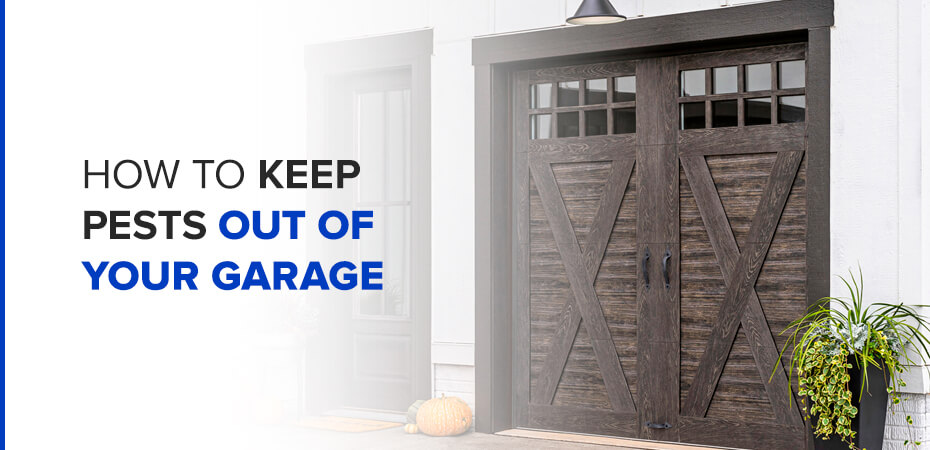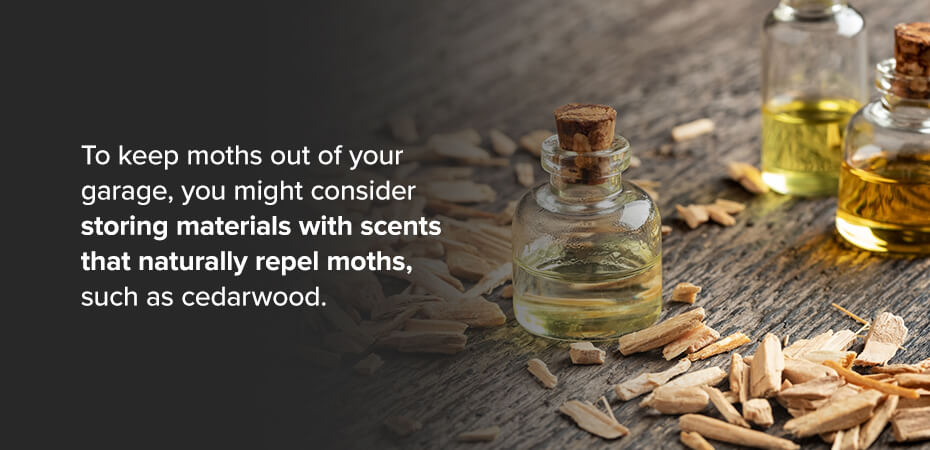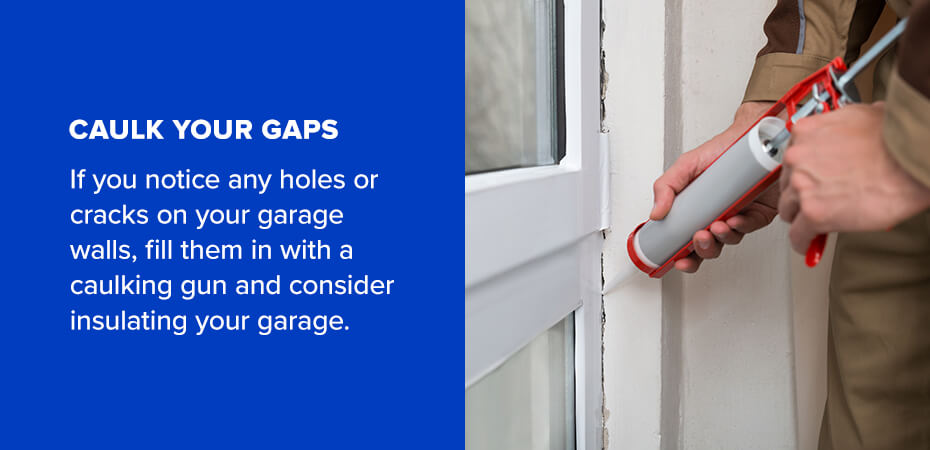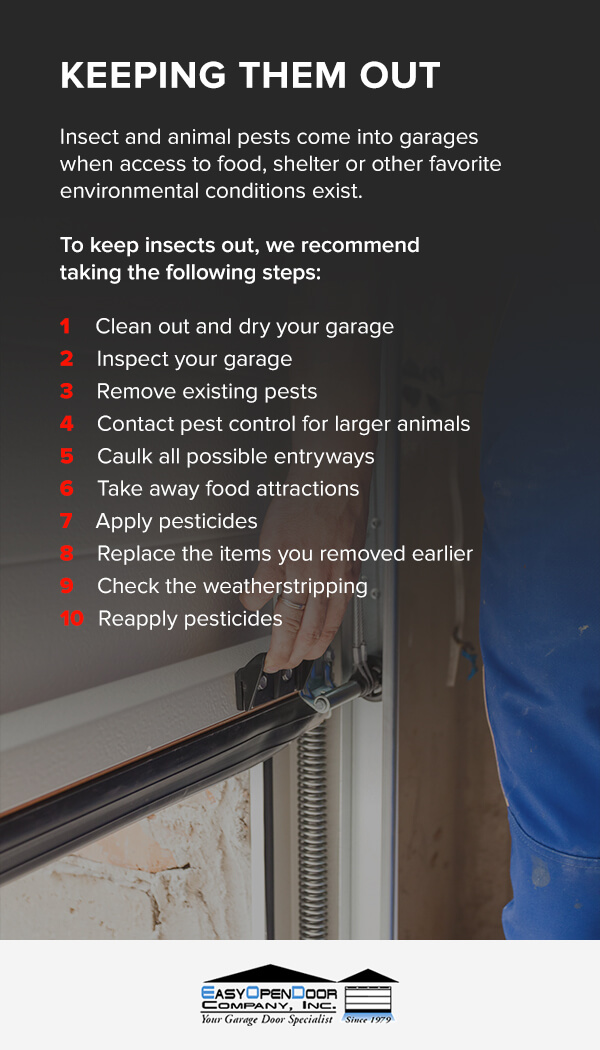
In this guide, you’ll learn the types of pests you can find in your garage, where they hide and how to eradicate them.
Table of Contents
Types of Pests in Your Garage
The first step to preventing or getting rid of pests in your garage is to identify them. Below are some of the most common pests that may take up residence in your garage:
- Silverfish: Although known to live in almost all areas of homes, silverfish particularly like garages. They gain access to your home in various ways, including by sneaking under doors or hitching a ride on cardboard boxes brought into the home. Once they gain entry, these pests will feed on clothing, glue, paper items and foods like meat and flour. As females can lay several eggs a day, infestations can quickly get out of hand. They tend to hide their nests in cracks and under objects.
- Deer mice: When the weather is cold, mice use garages for shelter from the harsh weather. Deer mice can present additional concerns as they carry diseases such as hantavirus pulmonary syndrome. They build their nests in wall voids and storage boxes and may even sneak into your vehicle, where they can get even warmer and chew on food crumbs and wires. As deer mice can squeeze through openings as tiny as a pencil, they can easily gain entry to a garage without proper sealing.
- Camel crickets: Camel crickets, whose name came from their humpback appearance, often come into garages during sweltering and dry weather. Their jumping ability also enables them to reach many different areas of your home, and they can damage clothing and fabrics, regardless of how high they are on shelves.
- Spiders: Spiders have trouble surviving in homes with effective pest control as they feed on small insects. For this reason, they go to places in your home where pests are more common, such as garages. Once they’re there, they’ll start making webs and laying their eggs.
- Sowbugs: These terrestrial crustaceans live in places with high moisture levels because they lack an exoskeleton, which would minimize water loss. For this reason, they remain inactive when the sun is out, hiding under objects to avoid moisture loss. You can find them around buildings, and from time to time, they gain entry to homes through door thresholds. If you have a sliding glass door, your home may be particularly susceptible to sowbug infestations. If you find more than one sowbug in your home, there’s likely a large sowbug population right outside your house.
- Flies: Flies are found in various areas of the home, including the garage. They are attracted to odors and air currents in homes and especially in garages. One of the most common ways flies may enter your home is through the garage when it is open. You can find house flies on practically any surface in your garage, including floors, walls and window sills.
- Ground beetles: Ground beetles generally tend to be found on the ground, hence their name. During the day, they generally hide under stones then become more active at night. During this time, they make their way into homes by crawling under garage doors without sealing. They may also fly through an open window.
Where They’re Hiding
Where do bugs hide in your garage? Insects prefer to hide in damp, dark places. As garages offer a variety of places for bugs to hide in and under, they’re often in places that are difficult for you to access. Places they may be hiding in your garage include:
- In the floor: Bugs may take up residence in cracks in your foundation.
- Behind the baseboards: They also like to take shelter in spaces behind baseboards that are not properly sealed.
- Under piles of objects: We often use garages to store boxes, wood and other materials. This habit often gets out of hand, however, and turns into a messy pile on the floor. Many rodents and insects are drawn to these piles for shelter, so it’s a good idea to keep your stored items organized and off the floor.
Getting Rid of the Ones You Already Have
To keep mice out of your garage and car and to get rid of flies in your garage, you will want to reconsider your food storage methods. The first step you’ll want to take is making sure any food you store in your garage is tightly sealed. You should use airtight containers to prevent vermin and insects from smelling any food, wrapped or unwrapped.
If you keep a fridge or freezer in your garage, remember that rodents and insects can often smell and track down any food stored in them, so ensure they’re tightly closed. If you spill anything on the floor, clean it up immediately. Even spilled birdseed can attract rodents and provide the optimal hunting ground for snakes.
There are several other reliable ways to keep your garage space pest-free and secure.
Removing Spiderwebs
While spiders are great for killing other pests by trapping them in their webs, they are nonetheless messy creatures. Their webs are unsightly and they often leave pieces of dead insects all over the floor.
To avoid this sight, you should remove the spider webs in your garage by dusting the corners once a week. Your garage will be more inviting as a result, and your guests will appreciate it, too.

Spraying Baseboards
Buy a good insecticide and spray the lower baseboard in your garage to keep bugs out of your garage at night. Make sure to get both the inside and outside so that any insects coming in contact with it will die immediately.
However, if you have young children or pets who play nearby or have toys lying around, be careful — insecticides are toxic. While there are non-toxic insecticides that might be safer, they’re generally less effective. If it rains, you should respray outside by the foundation.
To keep moths out of your garage, you might also consider storing materials with scents that naturally repel moths, such as cedarwood. Remember also to keep your garage floors clean to keep moths and other pests away.
Install Weatherstripping
If you want a pest-free garage, you’ll need to know how to keep bugs out of your garage. One of the most common ways that pests gain entry into your garage is under the garage door. Garage doors usually have gaps underneath, through which many kinds of insects can pass.
To reduce the chance of insects getting in this way and to keep bugs out of your garage windows, we recommend purchasing weatherstripping or rubber seals. You can find them in any hardware store or get them easily online. Make sure you buy the correct size for your door.
Weatherstripping also comes with another benefit — it improves the energy efficiency of your home. If your garage is letting in air from the outside, your AC or heating system must work harder to keep indoor temperatures comfortable.
Remove Stagnant Water
Water is one of the biggest attractions for mosquitos. These annoying pests tend to make their homes in water cans, barrels, buckets and practically anything holding water. They also use stagnant water to breed, and once mosquitoes start to multiply, it’s quite difficult to remove them. For this reason, make sure you have no stagnant water lying around your garage.
Remove Outside Anthills
Once every month, walk around your home and look around your foundation for anthills. Due to their extremely small size, these insects can easily get into your garage and, from there, any part of your home. If you notice any anthills, start setting ant bait traps around outside. You may be able to catch them before they make it into your house.

Caulk Your Gaps
If you notice any holes or cracks on your garage walls, fill them in with a caulking gun and consider insulating your garage. We recommend silicone caulk, as it is the longest lasting. By caulking these gaps, you can avoid insects that squeeze in through tiny cracks and close up larger openings to secure your garage from larger critters. The best way to get rid of snakes in your garage is to prevent and eliminate any possible entry points.
Learn About Garage Door Insulation
Take Out Cardboard Boxes
Most homeowners would agree that termites are the worst pest of them all — they can eat away at your foundation and compromise the structural integrity of your home.
These destructive creatures are attracted to organic materials like cardboard boxes and wood, which most people have stored in their garages. You can greatly reduce the chance of a termite infestation by keeping these termite favorites out of your garage.

Keeping Them Out
Insect and animal pests come into garages when access to food, shelter or other favorite environmental conditions exist. By eliminating these attractions and sealing off entrances — which you can do at little or no cost — you can minimize the chances of a pest invasion.
To keep insects out, we recommend taking the following steps:
- Clean out and dry your garage: Remove all the items in your garage, sweep your floors and dry any areas without obvious moisture by using a portable fan. Moisture attracts some insect species, and objects like pipes, furniture, clothing, pipes and boxes can provide shelter for small insects and animals.
- Inspect your garage: Take a close look at the walls, windows and ceiling using a flashlight. Looks for holes, cracks and other openings and, if you see any pests, try to identify them. While the pests themselves may not be in sight, there are many telltale signs of their presence, which include droppings, sawdust, spiderwebs, nests, chew marks on plastic bags, insulation cloth, wires and wood.
- Remove existing pests: You can do this by either applying pesticides or catching pests and letting them free outside using a broom and dustpan. A box or sturdy bag works as well. If you’re dealing with a large infestation or nest, consult a pest control company for the best course of action.
- Contact pest control for larger animals: If you have or suspect the presence of larger animal pests, call a pest control company. Animals sometimes carry harmful diseases and, if mishandled, they can scratch and bite. If you’re dealing with small rodents, set adhesive traps, baited mechanical traps or poison bait stations in the corners of your garage or near where you suspect the pests are entering.
- Caulk all possible entryways: Block any potential entrances you see in your walls, ceiling, foundations or around windows using silicone caulk. For bigger openings in stone, concrete or brick, use a masonry sealer instead. Block holes in your window screens using a screen repair kit, which you can find in many home supply stores.
- Take away food attractions: This can be done by regularly cleaning cooking grills and using covered trash containers. If you can, don’t put food waste in your garage until trash pickup day.
- Apply pesticides: Apply pesticide spray, powder or traps around the interior and exterior walls of your garage as well as the doors, windows and roof eaves. Only use traps and pesticides for pests you’ve identified or are most likely to get into your garage. Apply pesticide powder or spray across the entrance to your garage to form a barrier against the pests.
- Replace the items you removed earlier: Throw away any items that are unnecessary to minimize clutter. Try not to block the traps you set so you can periodically inspect and replace them.
- Check the weatherstripping: Check the weatherstripping on the sides, top and bottom of your garage door and entrance doors. If you notice that the weatherstripping is damaged — which is the case if you see daylight when the doors are closed — make sure to replace it.
- Reapply pesticides: Replace used or unused traps with the frequency recommended by your manufacturer.
When It’s Time for a Professional
While most homeowners can eliminate a small number of pests, there are several situations where it is best to contact a professional. Consider a professional exterminator if:
- Your pest control efforts are in vain: If you’ve tried method after method and nothing seems to work, consider using the services of a professional exterminator — especially if the problem is getting worse.
- You feel your family is possibly in danger: If you try to destroy a wasp nest and are unsuccessful, you will have some angry wasps on your hands. Many pest bites aren’t just painful — they can be dangerous, especially if someone in your family is allergic to their bites. Chemical pesticides can also be harmful to your kids if misused. If you are worried that your intervention is potentially harming your family, call in experts.
- You hate insects: If you’re not comfortable dealing with these intruders by yourself, consider calling a professional exterminator.
- Your specific problem requires professional attention: Some infestations may be too difficult to eradicate without the help of an exterminator. Bed bugs, for example, are very hard to get rid of, and you’ll need a team of experts.
Make Sure Your Garage Door Isn’t the Problem
Sometimes the solution to your pest problems is as simple as repairing or upgrading your garage door. When you need dependable garage door maintenance and installation solutions, you can trust Easy Open Door. For nearly four decades, Easy Open Door has provided homeowners all over San Diego County with top-notch garage door installation and repair services.
For qualified, expert assistance with all your garage door needs, contact us and receive concrete solutions today.



